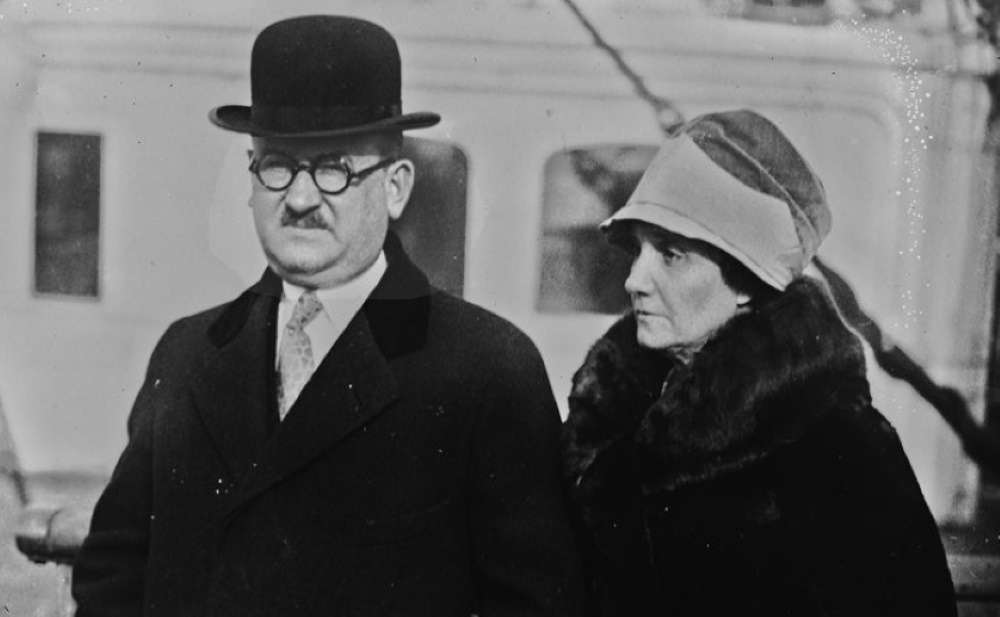In 1919, the Federation of Canadian Catholic Churches in America decided to tackle the need for better schools. Catholic parish schools adequately served younger students. But for high-school age students, the existing institutions were deemed inadequate.
The Federation intended to change that with a series of state-of-the-art high schools, and it would start in Woonsocket, R.I. At times, Franco Americans made up more than three-quarters of the Woonsocket population, many drawn from Canada by the vibrant mill economy.

Elphage Daignault, architect of the Sentinelle Affair, and his wife
The Providence Catholic Diocese unveiled plans for the Mont Saint Charles Academy in Woonsocket with fanfare. The Franco-American population embraced this proposal for a fine new school. But as fundraising for the school began, rumors began to circulate. The new school would conduct classes in English only. French would only be taught as a separate language course.
The decision to push Franco-American students through an English-speaking school touched a nerve and ignited the Sentinelle Affair. The Sentinellists decided to preserve the French language in the church, community AND schools..
At the center of the Sentinelle Affair stood Elphege J Daignault. As the controversy raged from 1923 through 1929, Daignault earned a reputation as a savior of French-Canadian culture – or an agent of Satan, depending on your point of view.
Daignault – born in Woonsocket in 1879 — studied at college in Montreal, Boston and New York. From 1922 to 1936 he served as president of the Canado-American Association.
Elphege Daignault and the Roots of the Sentinelle Affair

Mont Saint Charles Academy Postcard
In the 1920s, the French language was under assault in states around the country. Many enacted English-only laws to discourage immigrants from retaining their native tongues in their new home in America.
Italian communities had founded the Knights of Columbus, closely aligned with the Catholic Church, to defend against attacks on Italian culture. The Franco-American community followed up with the Order of the Crusaders to serve the same purpose. A secret society, it worked to counter anti-Canadian bias.
By the time of the Sentinelle Affair, Elphege Daignault had already made himself a thorn in the side of the Providence Diocese of the Catholic Church. In 1914, he led a group that forced Bishop William Hickey to remove the French Marist Fathers from the Sainte-Anne Parish of Woonsocket and replace them with a local, native Franco American.
The plans for the English-only high school outraged Daignault and his supporters. A lawyer, judge and politician, Daignault opened up two lines of attack on the plan. He sued in state courts, accusing the church of improper use of funds by soliciting donations from Franco-American Catholics. The funds were used for projects that not only didn’t specifically serve their community, but actively undermined the community by attempting to snuff out the French language and culture.
Daignault argued the church method of pooling all donations did not comply with the terms under which it solicited them.
He took a second tack, filing appeals with the Vatican asking it to intervene in the matter and to halt the Anglicization of church schools.
La Sentinelle is Published
In addition to trying to win his case in the courts of the Vatican and Rhode Island, Daignault also decided to turn to the court of public opinion. To promote his point, Daignault took an active role in running a Woonsocket newspaper: La Sentinelle.
While many Franco-Americans supported Daignault’s views, they generally were not as hostile and direct while challenging the church.
He accused his enemies of murdering the French culture and of operating deceitfully.
He also turned the fight into an ethnocentric attack on Irish-American Catholics, a prominent force in the American Catholic Church. Irish clergy, he contended, were “national assassins.” And he called their French Catholic supporters traitors to their people. The church had embraced the unstated goal of Irish domination. Daignault also mocked the Irish for embracing the language of their oppressors – the English.
Daignault’s megaphone grew as newspapers in Holyoke, Mass. and Nashua, N.H. echoed his editorials, which he sometimes signed and sometimes wrote under the pseudonym Blaise Juliet.
Opposition to Daignault
Daignault’s voice was not the only opinion found in the Franco-American press. His critics voiced their opposition in newspapers in Manchester, N.H., as well as Holyoke, Woonsocket and Lawrence in Massachusetts.
They accused Daignault of trying to foment a modern crusade and creating controversies where none existed. He vilified his enemies, they charged, by challenging their patriotism simply because they disagreed with him.
Even many who agreed with Daignault could not support his vitriolic attacks on the church.
Taking the Fight to New Hampshire
Far from backing down, Daignault took his campaign to Manchester, N.H. In that state the language issue also simmered as Bishop George Albert Guertin worked to modernize New Hampshire’s Catholic schools. Guertin also planned to limit the speaking of French to just language classes.
Daignault attacked popular Franco-American priest P.J. Ernest Devoy, an advocate for education. Devoy, he charged, was bilingual but never used French in his official capacity. Daignault called it a “diabolical” practice.
But there was growing weakness in Daignault’s campaign. He could draw a sizable crowd to rallies, but regular Catholics were wary of his attacks on the church.
Then the Franco-American Catholic Federation in 1924, at its annual meeting at Willimantic, condemned Daignault’s tactics.
He lost his court challenges in the Rhode Island courts. His requests to the Vatican yielded no support. Finally, the machinery of the Catholic Church stopped tolerating his dissent.
In 1928, the Vatican declared it would hear no more from Daignault. The church authorized Bishop Hickey to excommunicate Daignault and 62 of his followers. Daignault then attempted two more Hail Marys. The Rhode Island Supreme Court threw out his final lawsuit. And when he sought legal protection within the Vatican courts against excommunication, he failed.
Finally, in January of 1929, Bishop Hickey delivered a message to Daignault and his supporters. If they did not renounce their position and repent before Easter, he would then bar them from entering any Roman Catholic Church.
Daignault caved. He publicly promised to seek forgiveness from the church authorities. He also apologized so the church would readmit him. Hickey called it the “greatest consolation I have had since the unfortunate movement was launched.”
The End of the Sentinelle Affair
The church defeated Daignault, but it did not completely silence him. He continued writing articles urging Franco-Americans to retain their culture. Then in 1933, a stroke slowed him substantially, and in 1937 he died of a heart attack.
This story updated in 2022.
Thanks to:
The Sentinel Affair (1924-1929) and Activist Survival: The Franco-American Experience in Woonsocket, Rhode Island, by Richard Sorrell. The Sentinelle Affair: A Study in Multilingual Language Practices, by Jason Peters. Elphège J. Daignault et le mouvement sentinelliste à Manchester, New Hampshire, by Robert B. Perrault. And Rhode Island and Connecticut newspapers.
Image: Mme et M. Elphège Daignault : d’après la photographie originale de l’agence photographique Pacific and Atlantic.
